It appears we have reached the point in the season that seems to arrive every year at some point, where clubs start getting (sometimes unnecessarily) impatient and show that by sacking their manager. While we could sit and explore the various pros and cons of making an early managerial change for hours, it may be of more interest to discuss one of the most highly-rated young managers in non-league football and why he could be ready to make the leap to an EFL club – particularly a League One or (the more likely option) a League Two club.
We are, of course, referring to Mike Williamson, who is currently enjoying a successful start to the season with north-east club Gateshead, who sit sixth in the table at the time of writing. In recent weeks, former Newcastle United defender Williamson has been the subject of rumours regarding a move to an EFL club thanks to Gateshead’s impressive rise since his arrival. In light of these rumours and the sincere possibility that Williamson does soon attract EFL interest, this scout report will provide a tactical analysis of Gateshead’s positive start to the season, with a view of their effective attacking tactics.
Manager Overview
39-year-old former Premier League central defender Mike Williamson joined the Tynesiders as a player in the 2018-19 season when the club suffered relegation to the National League North. In time for the following campaign, he was appointed player-manager.
However, despite taking charge at the start of the 2019/20 season, his first full campaign did not come until 21/22 (due to back-to-back seasons being cut short due to the pandemic), which incidentally is when Gateshead stormed their way to the National League North title, winning the division’s manager of the year award along the way.
A team whose strongest asset is their attacking output, that title run was helped by a certain Macauley Langstaff, who scored 30 goals that season – the forward then moved to Notts County, where he continues to strive at League Two.
Langstaff’s departure and losing the likes of Cedywn Scott made Gateshead’s first year back in the National League even more difficult. Yet, Williamson guided them to an impressive 14th-place finish.
They also went on a cup run, reaching the final of the FA Trophy, only to fall at the final hurdle. The club have built on their momentum from last season, having inserted themselves into early playoff contention in a strong National League.
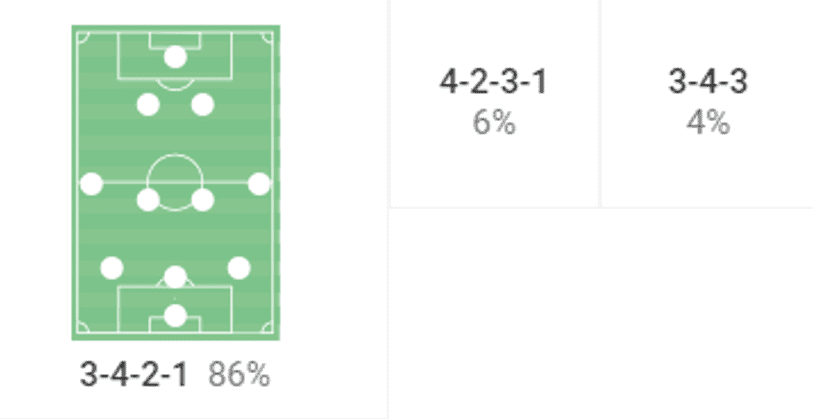
In terms of pure numbers, it makes for good reading for both Williamson and Gateshead. Of his 174 games in charge to date, he has amassed a win ratio of 47.1%, and their attacking numbers are seriously remarkable, too, but we will explore those later in the analysis. While Gateshead experienced a fair number of formations last season, their primary shape – both last season and this campaign, has been 3-4-2-1, which compliments their attacking possession style nicely.
Early possession phases – build the attack.
Often in football, no matter the level in question, having the best individual players can sometimes be enough to secure all three points in a match. However, having a squad of players that bring technical talent and a strong tactical understanding where they suit the team’s tactics well can be the key to simultaneously producing consistency and quality.
Last season in the National League, eventual promotion winners Notts County won numerous plaudits for their possession-based style of play, and this season, we are seeing Gateshead receiving praise for their take on a possession-based system – tactics which require good teamwork and strong tactical understanding.
This allows Williamson’s tactical vision to come to fruition as we often see his team carrying out a clear tactical direction through various areas of play before they even reach the final third.
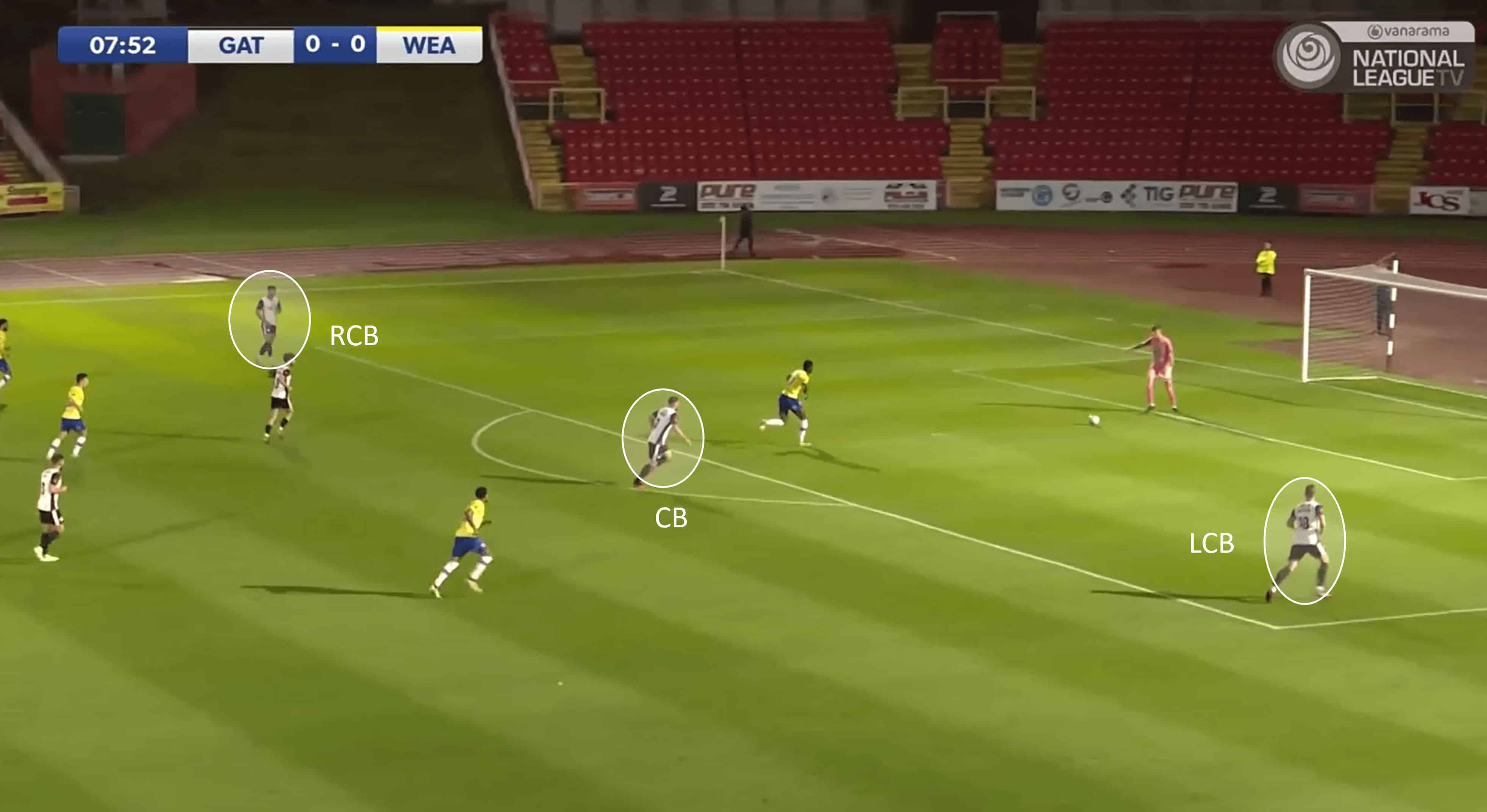
When playing out from the back, this is how Gateshead typically shapes up – the width between the three CBs is necessary for allowing them to play out from the back – a crucial part of their tactics in the build-up phase. Often, the CBs in this kind of position they will look to move the ball into wherever the space lies: either a pass out to the high and wide wing back or into the deep midfielder once he has found the space which allows for such a pass.
The two deeper midfielders are often close by, not only to offer themselves as an immediate passing outlet but, as you’ll see in the next analysis image, to act as a decoy to create space for the other deeper midfielder (or another nearby teammate).
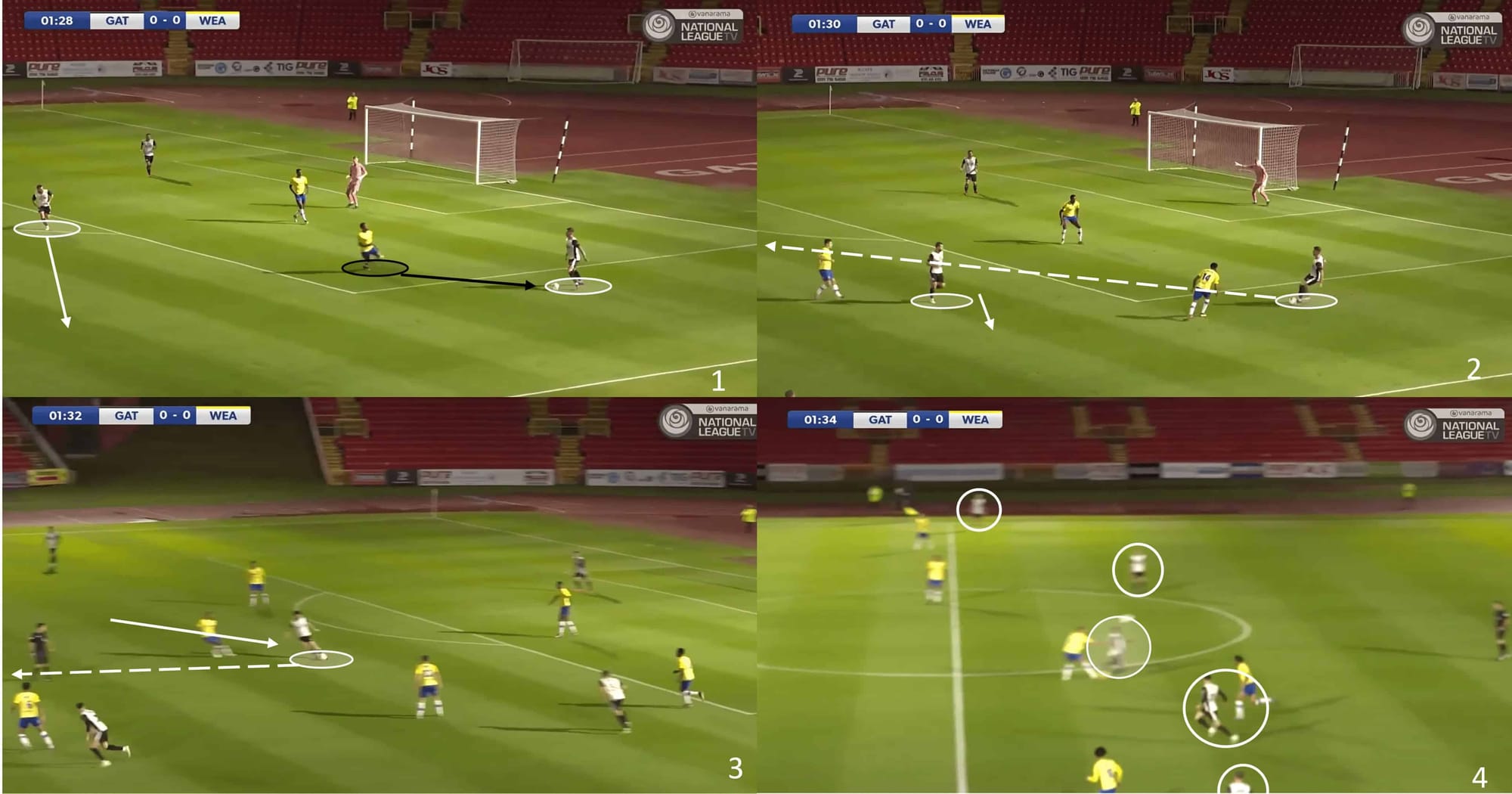
Above is a breakdown of a possession phase of Gateshead in their own half – the move comes to a halt at the halfway line when they win a free kick, but the possession before this event contains some critical aspects of Williamson’s tactics. The move starts with deep possession at the feet of the LCB, who looked adamant about playing out from the back rather than going long – although Gateshead do use the direct approach to good effect when required.
It appears to be something they work on as a plan B if you’re to read into the data. They have the highest average in the division regarding progressive passes per 90 (81.65) and are also the most accurate (78.1%), highlighting an absolute consistency in this area.
From there, we see a move we mentioned earlier – the nearside deeper midfielder drifts into the space across his teammate on the ball, dragging an opposition midfielder with him. As a result, there is now exploitable space behind him, which Gateshead use to progress their possession through a central area quickly. And, of course, as we mentioned, that is when they win the free kick on the halfway line.
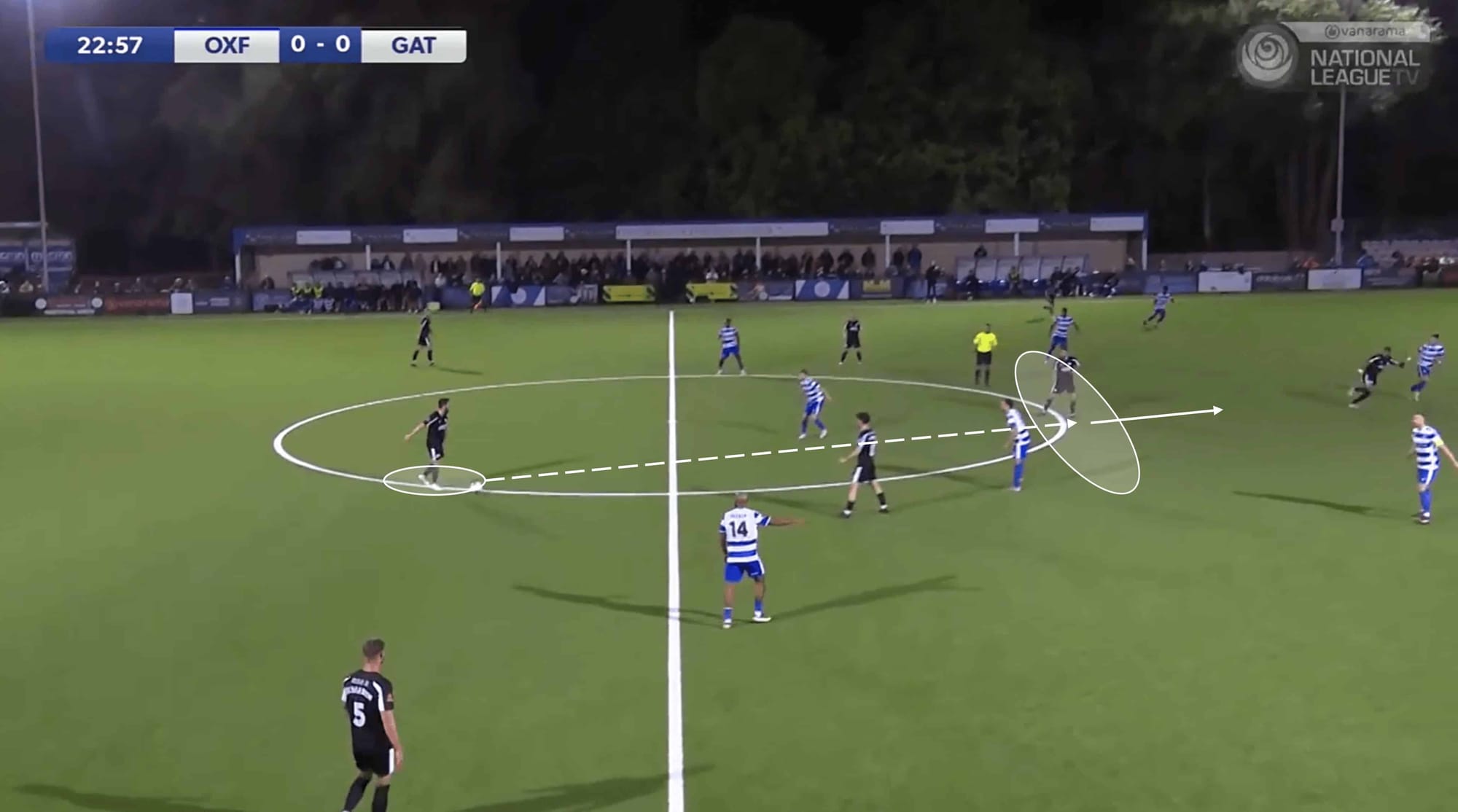
Playing through central areas has been an absolute staple of Williamson’s tactics. That isn’t to say they don’t utilise wide areas via the wing-backs because they do, but that often comes later in the phase.
Naturally, when they have possession near the halfway line with the opposition executing a block in their own half, Gateshead’s overall shape becomes wider with the wing-backs really pushing on. This can cause some disarray in the opposition midfield ranks, which eventually presents Gateshead with the chance of a clear line-breaking pass into an advanced position, just as you see above.
There are several examples of Gateshead playing this type of pass this season – carving teams open with a central pass, taking advantage of the expectation to play the ball into the flanks.
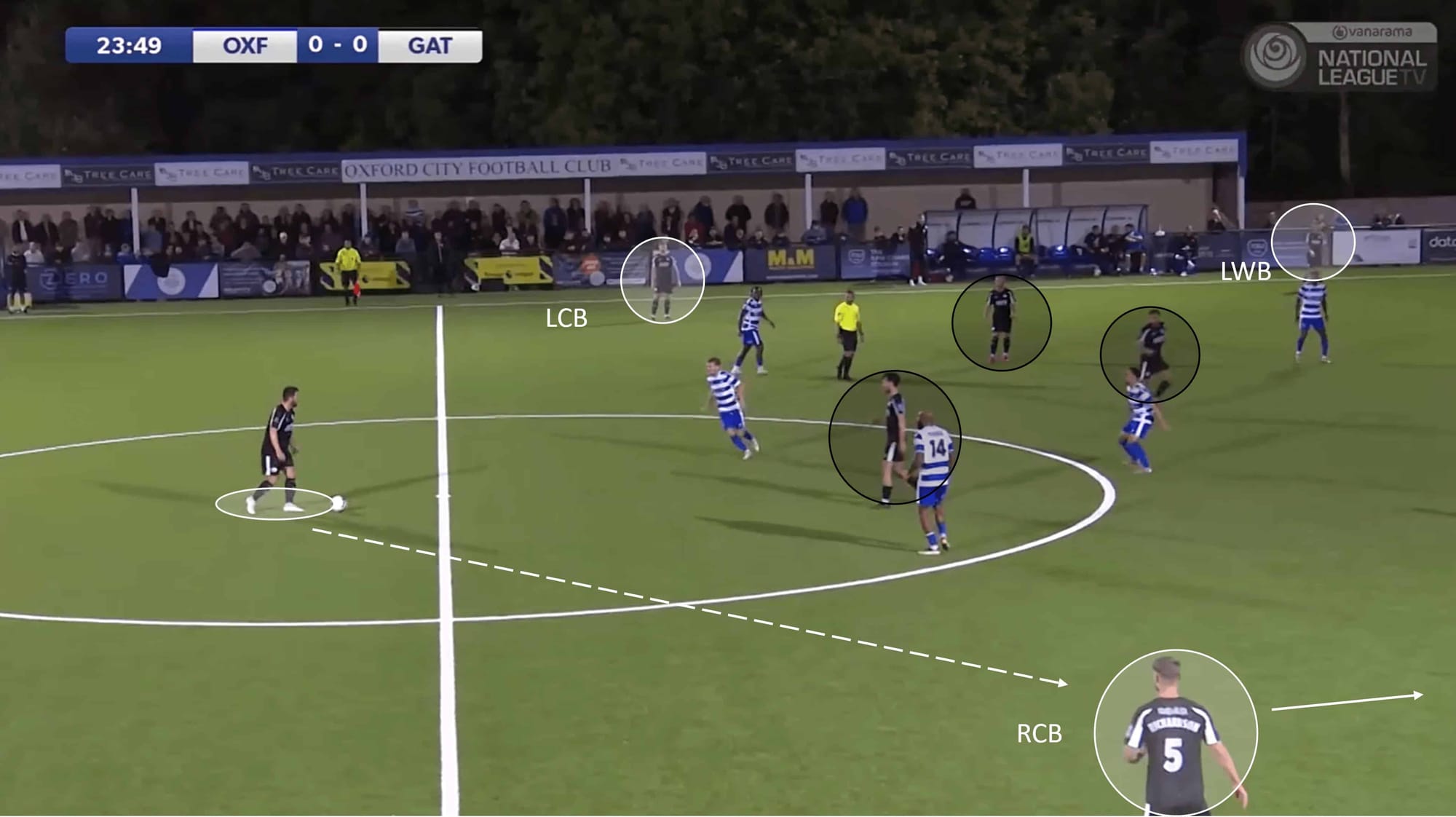
When they have a firm grip on the game and possession itself, Gateshead really come into their own, and this is where we start to see some unique tactical elements. Doubling back to their ability to dominate possession first, though – last season, despite finishing in the bottom half, they still had the fourth highest possession rate, averaging 55.7% per 90 minutes. Thus far this season, they have surpassed that number and then some, averaging 65.7% possession per 90 – the highest in the whole division. Williamson’s tactical imprint is clear.
What helps them with such ball domination is the technical ability and consistency of the players at the manager’s disposal – they have the highest average in the league for passes per 90 (566). They are also the most accurate in the National League, as evidenced by their pass accuracy rate of 87.3%.
These numbers also relate to the image above, as their dominance is aided by the positioning of supporting players, particularly the wide CBs in this case. Modern football is seeing more and more the use of wide CBs stepping into a midfield role in possession. As you can see above, both the left and right CBs have taken up positions matching that description and often do in these situations.
Precise and deadly in the final third
As the following segment of analysis will show, Gateshead are not only dangerous in the box, but their possession play as they progress into the final third is often patient yet still with an excellent pace to the play – they currently boast the highest passing rate in the league with 15.1 (passing rate – passes per minute of possession). Their ability to play passing combinations in tight areas while utilising clever and well-timed off-the-ball movements is a credit to their tactical understanding as well as their team cohesion, all aspects Mike Williamson deserves a pat on the back for.
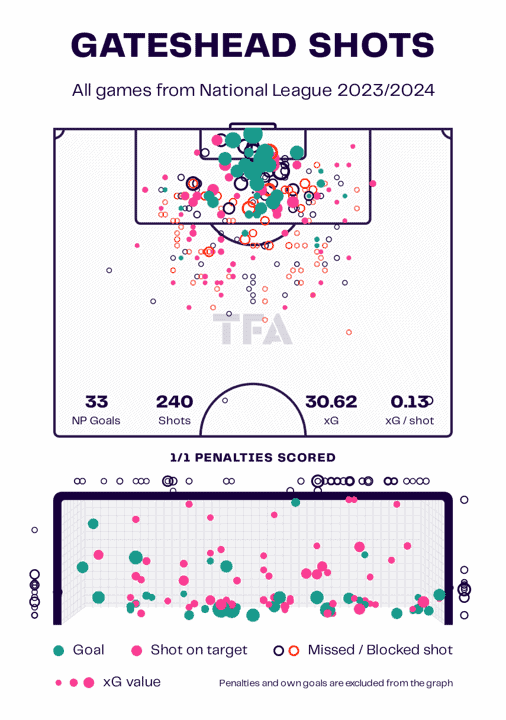
Ironic, isn’t it – that one of the best attacking teams in non-league have been made that way by a former Premier League defender? Well, that’s precisely what Gateshead are, and while we could sit and discuss some of the weaknesses in their defence which may eventually hold them back, they are simply undeniable in attack and a joy to watch.
Let’s drill deeper into the data than the stats in the image above. Now, Gateshead do currently have the second-highest goal tally in the league with 34 goals (second only to league leaders Chesterfield). Still, they have achieved this feat from just 14.28 shots per 90, which happens to be one of the lower registers in the division. It doesn’t seem to hold them back, though, as they have the highest overall xG register in the division (31.38) – the low shot average harks back to the earlier about being patient in possession and striking right at the perfect moment.
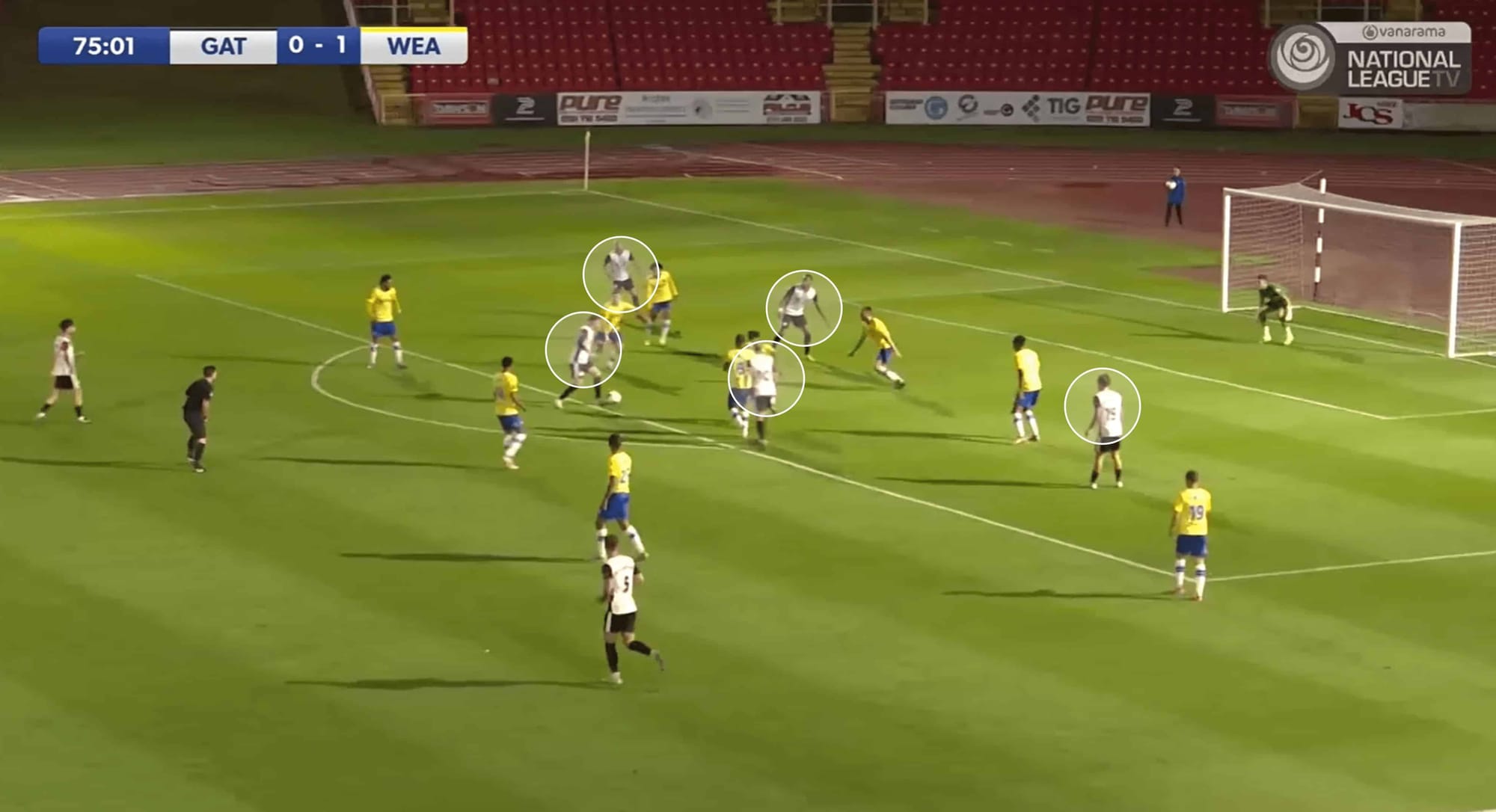
Adapting to different situations in possession has been a real strength for Williamson & co. This season, getting bodies and possession inside the box has been ever-present. Even in these scenarios, they remain composed and patient, carefully selecting the next pass or, in the case above, shot. This requires various psychological and technical attributes, with the key ones relating to good movement, timing (both on and off the ball) and decision-making. Playing in the opposition box is something they are used to, which is told in their 21.33 touches in the box per 90 – the second-highest register in the National League.
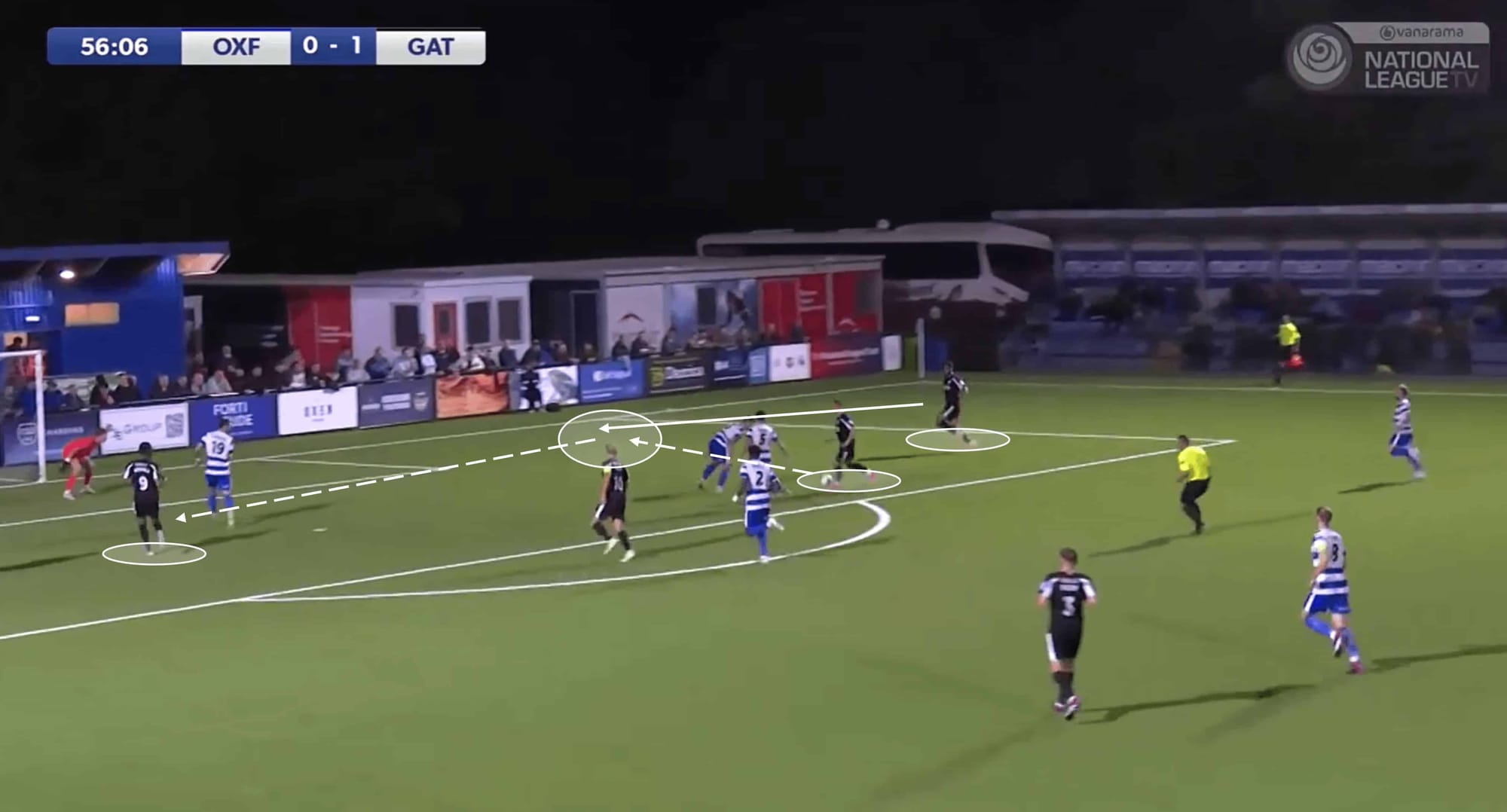
Looking at their play in the final third, when they have already surpassed the opposition midfield unit, we see some of the attacking elements you may have expected to see sooner in terms of bringing the wing-backs into play. This isn’t to say these wide players don’t make a solid contribution in earlier phases; they do, but they make a much more significant impact in these areas, often playing essential roles in goals and dangerous chances.
Take the shot above, for example. We see Gateshead entering the opposition box with a bursting overlapping run made by the right wing-back – his run is met with a simple yet well-executed pass, presenting the opportunity for a low cross into Marcus Dinanga.
Dinanga has been in excellent form this season, bagging 12 goals in 15 games. His skill set is also something to behold, as the 26-year-old regularly shows natural striker instincts. One simple yet crucial example of this is seen in the image above – his positioning and off-the-ball movement to be a serious option for the cross shows real game intelligence. The forward has impressed with his versatility in possession this season; from winning aerial battles and holding the ball up to running in behind to get on the end of a through ball, he has been one of Williamson’s star men.
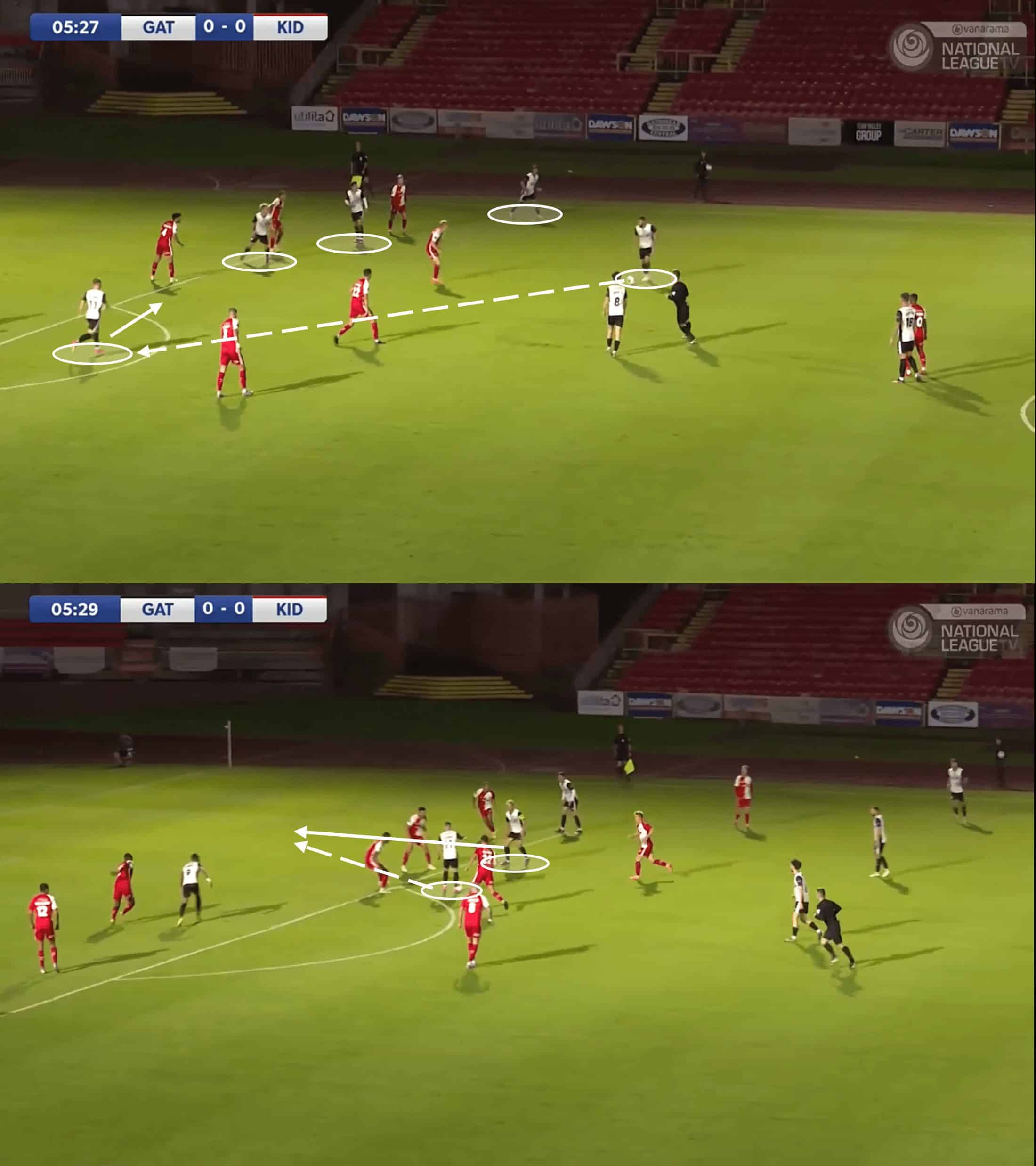
This final in-play example highlights some of the aforementioned aspects of Gateshead’s play – a blend of patience and precision to unlock the opposition’s defence. From the initial clever movement from Stephen Wearne to find space on the edge of the box to the heavy attacking presence making life for the opposition strenuous to the final well-timed through pass, there is a real consistency and pattern to their play.
Diving into some of their data related to the final third play, you won’t be shocked to learn that, just like many of their general possession stats, they rank amongst the league’s best in several areas. Key passes, for example, of which Gateshead average 4.44 per 90, is the league’s highest average, highlighting a talent in presenting teammates with chances on goal. They are also consistent in the moments before their final approach – 61.03 passes to the final third per 90 minutes is the second-highest average in the league, and they match that with the third-highest accuracy rate.
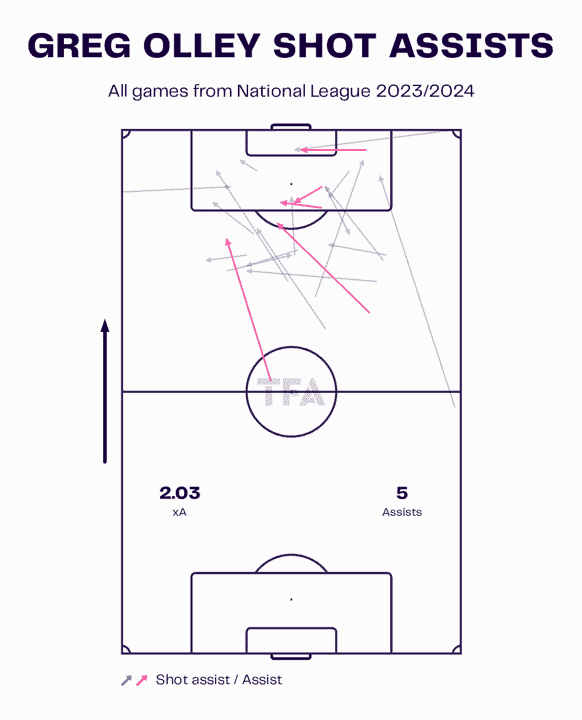
We mentioned in the intro that just having good players alone is sometimes not enough over the course of the season and that, in fact, a combination of technical ability and tactical understanding can be the key to success. Well, Gateshead midfielder Greg Olley has embodied that this season, in an attacking sense at least. The club captain recently reached 200 games, and Mike Williamson himself labelled Olley “Mr Gateshead”, a true compliment and a credit to the midfielder’s contributions. He’s hit the ground running this season, with eight G/A already – three goals and five assists. His assist map above shows how dangerous he can be on the ball, creating a whole batch of chances from and to central areas.
Conclusion
One of the most exciting teams in non-league, managed by one of the most sought-after managers in the National League, Gateshead are absolutely flying and will be backing themselves to launch a playoff push this season. While that will still be a monumental task, they have demonstrated early on that they aren’t collecting points on a fluke – their performances and the data prove that. But IF Williamson is to depart this north-east project, where does he go?
In recent weeks, he’s been linked with fellow National League North side Oldham Athletic, while League Two clubs Gillingham and Bradford City have also been mentioned. It will be interesting to see where Gateshead and Williamson are at the end of the season, but don’t be surprised if the former defender opts to finish the story with the Tynesiders.

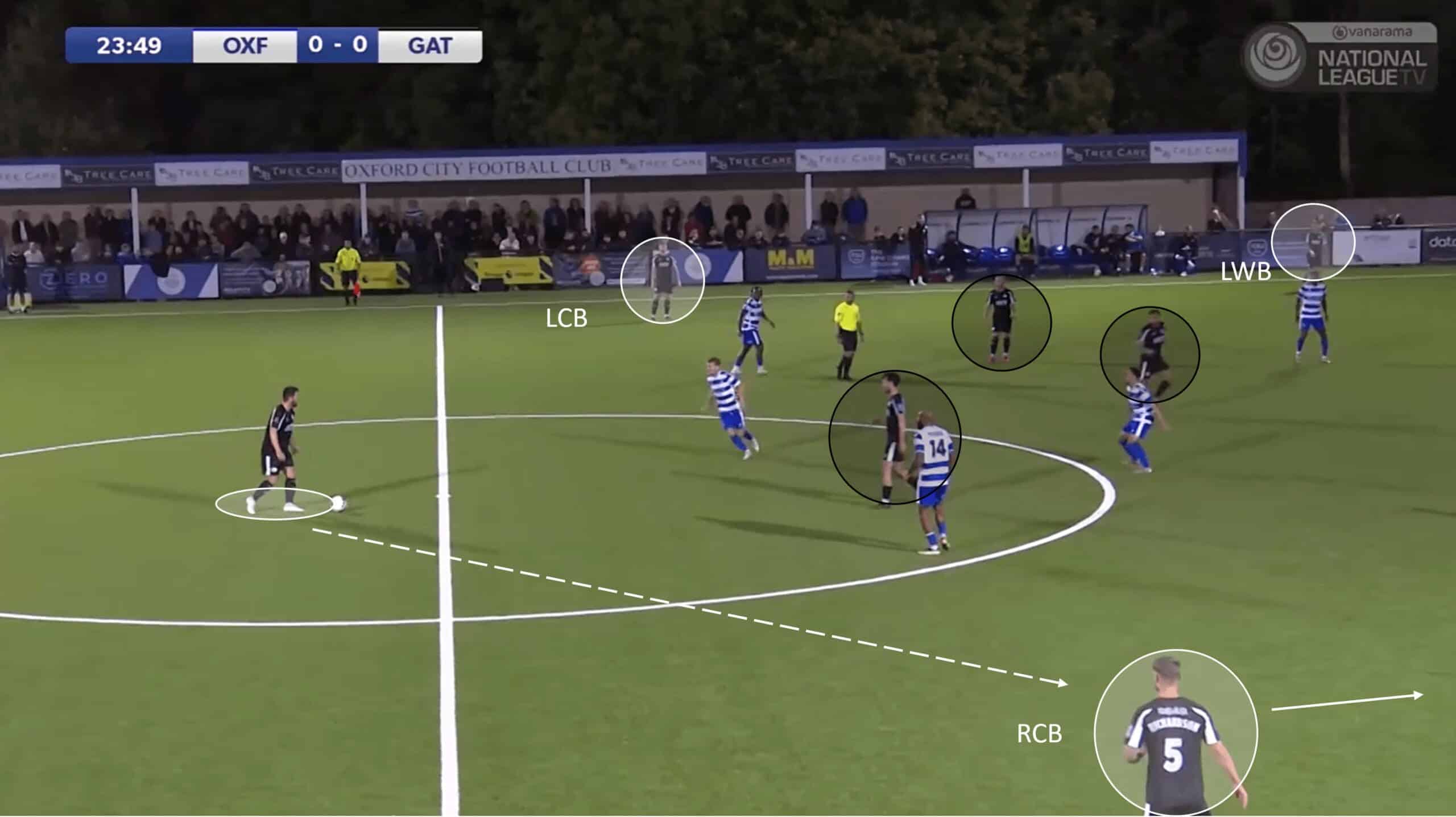




Comments